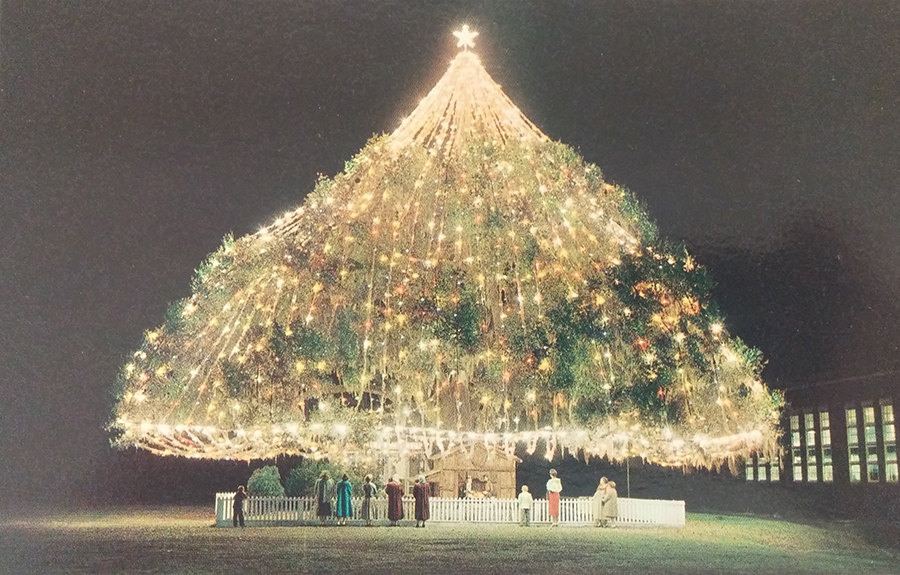O Christmas Tree!
Once upon a time, historic Hilton Park was a place to be seen — especially beneath the world’s largest Christmas tree
By Chris E. Fonvielle Jr.
Neither inclement weather nor sickness among church choir members could dampen the spirits of the revelers who attended the first lighting of “the living community tree” at Hilton Park in Wilmington, North Carolina, on Christmas Eve night, 1928. Some 750 multicolored lightbulbs that adorned the massive live oak glowed and sparkled even more brightly against the dark background of low-hanging clouds and a cold, misty rain. It was pure Christmas magic. “Living Tree of Cheer Lightens Hearts of Many” read the headlines of the Wilmington Morning Star the next day. Over the following 81 years, the ritual at Hilton Park of lighting the same old oak tree, which Wilmingtonians boasted was the world’s largest living Christmas tree, marked the true beginning of the Christmas season in the city.
The holiday “community affair” was the brainchild of James E. L. “Jimmie” Wade, city commissioner of public works, who later became mayor of Wilmington. He was a jovial, colorful character who usually wore a fine suit and fedora, which he tipped to the ladies, and greeted gentlemen by saying, “Hi, buddy.” Until his dying day, he was known about town as “Hi Buddy” Wade.

How the ancient oak tree in Hilton Park was chosen to be the annual symbol of Christmas in Wilmington is an interesting story in itself. In 1927, Commissioner Wade offered a shiny silver dollar to the school boy or girl who found the largest living tree in or near Wilmington, which he proposed to deck out for the holiday. A giant live oak standing more than 75 feet in height, with limbs spreading 110 feet and dripping with Spanish moss, was chosen the winner. Estimated to be at least 300 years old, the tree stood in Hilton Park on a high bluff along the Northeast Cape Fear River near its confluence with Smith’s Creek on the northern outskirts of Wilmington.
The site was steeped in history, dating back to the earliest days of the province. In 1728, the British Crown granted to John Gardner Squires 300 acres along Smith’s Creek, named for William Smith, another early land grantee in the region. Two years later, Squires sold the tract to John Maultsby, who kept it until 1753. The new owner, William Moore, made vast improvements to the property, in part by building a stately brick “mansion house” within a sprawling grove of live oak trees. He named his plantation Maynard. Following Moore’s death, Cornelius Harnett Jr. purchased almost 300 acres from Maultsby’s estate between 1753 and 1756.
Cornelius Harnett Jr. is the person most closely associated with Hilton’s history. He was a member of a prominent family that was among the first to colonize the Lower Cape Fear. In his younger years Harnett lived in Brunswick Town, the earliest enduring settlement on the Cape Fear River. He eventually relocated, as did most citizens of Brunswick Town, upriver to the more thriving community of Wilmington, which had been incorporated in 1739. Harnett soon became a leading merchant, planter and distiller. The vast wealth he accumulated enabled him to purchase Maynard. It was said that his wife, Mary, grew enough fruits and vegetables in her garden at the plantation to feed the whole population of Wilmington.
Harnett became active in public affairs and was elected to serve on the town’s commission and then in the colony’s General Assembly. In 1770, Cape Fearians chose him to head the local chapter of the Sons of Liberty. After meeting Harnett at Maynard while traveling south in 1773, Josiah Quincy of Boston described him as the “Samuel Adams of North Carolina.” In November of the following year, the Wilmington Committee of Safety elected Harnett chairman, and he emerged as one of the leading patriot figures in the colony during the American Revolution.
Considered a rebel by the British government, Harnett became a target for redcoat forces that captured Wilmington in 1781. They soon arrested and imprisoned him in a roofless blockhouse, where he died from exposure and disease. Harnett was buried in the graveyard at St. James Anglican (now Episcopal) Church underneath a fitting sandstone marker that still stands near the southwest corner of Fourth and Market streets in downtown Wilmington.
In 1784, Harnett’s widow sold Maynard to John Hill, brother of William H. Hill, co-executor of the estate. Four years later, John sold the plantation to William, who renamed it Hilton. Hill’s inexplicable omission of one “L” from the spelling led some chroniclers to mistakenly believe that the place was named for William Hilton, a Puritan seafarer from Massachusetts Bay Colony who was the first documented European to explore and settle the Lower Cape Fear, between 1662 and 1664.
By 1853, James F. McRee, Jr., a noted Wilmington surgeon, owned Hilton Plantation. Soon after taking possession, he conveyed a parcel to Oscar G. Parsley, a member of the board of directors for the Wilmington and Weldon Railroad, the longest rail line in the world at the time. Parsley built two houses and a steam saw mill at Hilton. During its occupation of Wilmington in the closing days of the Civil War in 1865, Union troops encamped on the grounds of the plantation.
By 1870, Henry Savage had acquired marshlands near Smith’s Creek and opened the Hilton Rice Mill. That same year, an enterprising businessman named Christian H. Hussell opened a beer garden at Hilton. The Clarendon Water Works later constructed a reservoir at the site.
In 1884 Wilmingtonians began lobbying city officials to convert Hilton into a community park. “The largest city in the state has no place of resort for her people,” one citizen lamented, “and there could not be found a more eligible point than Hilton.” It took a while, but in April 1892, the Wilmington Street Railway Company bought 12 acres at Hilton for development as a resort.
The transaction may have been motivated in part by the loss of Cornelius Harnett’s 140-year-old mansion. Despite the efforts of the Wilmington Historical and Scientific Society to preserve the historic structure as a “Revolutionary relic,” the Peregoy Lumber Company, which had recently purchased the parcel of land on which the house sat, demolished it in March 1892.
The Wilmington Street Railway Company constructed a pleasure ground for picnicking, a field for baseball games and other sporting activities; and a pavilion for music, dancing, and refreshments at Hilton. For a nominal fee, the company carried excursionists by electric trolley out to the park, two miles north of the city’s center. Tourists could also travel there by steamboat, including on the Wilmington, the Eleanor, and the Little Sam, from Wilmington’s downtown docks.
Hilton Park quickly became the place to be. As early as the summer of 1892, baseball teams played on a “splendid field” enclosed by a wooden fence, church and school groups held “lawn sociables,” and families picnicked in the grove of oak trees, while brass bands played open air concerts. Football games, bicycle races, track and field events, gun club matches, fairs, circuses, oyster roasts and military encampments were also regular occurrences on the grounds.
In October 1895, Buffalo Bill Cody brought his Wild West Show, featuring Miss Annie Oakley, the famous dead-eye sharpshooter, to Hilton Park. Wilmington’s gentry formed the Cape Fear Golf Club in 1896, and the following spring constructed seven holes for play there. On Thanksgiving Day 1896, a squad of the best local “elevens” was assembled to play the University of North Carolina’s football team on Hilton’s gridiron. In a unique sporting event at the time, the New Women beat the Old Maid’s women’s baseball team in a close game at the park in September 1897.
Political rallies were also held at Hilton. On November 8, 1898, Democrats, led by extremists called Red Shirts and Rough Riders, held a “White Man’s Rally” at Hilton Park. Two days later they launched the bloody Wilmington Race Riot against black Republicans and their white allies to overthrow the city’s legitimately elected government.
Ironically, although social events at Hilton were segregated, African-Americans had also enjoyed the park’s facilities up until the Riot of 1898. In one earlier baseball game, Wilmington’s black team, Schenk’s Black Stockings, had defeated the Red Stockings of New Bern.
For three decades, Hilton Park remained the most popular outdoor venue for cultural, social and political events in southeastern North Carolina. By the early 1920s, however, activities and attendance began to wane. Competition from other places of play — Robert Strange Park at 14th and Market streets, Hugh MacRae Park in the eastern part of New Hanover County, Wrightsville Beach, and Carolina Beach — siphoned a lot of park-goers and events from Hilton.
Perhaps in an effort to restore Hilton Park to its glory days, Commissioner Jimmie Wade promoted the idea of lighting the same oak tree every night during the Christmas season. His efforts were successful, at least for that event. Beginning in 1928, the ceremony became a traditional and must-see affair. Every year, thousands of visitors drove out to Hilton Park to observe the world’s largest living Christmas tree.
Although the dates changed from year to year, Hilton’s tree was lighted nightly throughout the Yuletide season except for a time during World War II. The tree was said to be more beautiful than ever in 1949. From December 6 until New Year’s Eve, it burned brightly with 5,000 lights, while glass ornaments and strands of Spanish moss hung from its stout branches. Reportedly, the grand sight attracted 130,000 people from 41 states and 14 foreign countries in that year alone.
Free nightly programs included the singing of Christmas carols, hymns, spirituals and gospel songs by church choirs, service clubs and school groups, and performances by bands. A reading of Clement Moore’s 1823 poem, “A Visit From St. Nicholas,” more commonly known today as “’Twas the Night Before Christmas,” was also a regular feature. (As an aside, I memorized and recited the poem to children one night during the Christmas season of 1981.)
The most popular attraction for children, of course, was a visit from Santa Claus, often portrayed by “Hi Buddy” Wade, as well as Mrs. Claus. Tiny tots waited eagerly, if impatiently, for their turn to sit on Santa’s lap in his makeshift cottage and reveal their Christmas wishes.
By the mid-1980s, the old tree at Hilton Park had seen better days. Severe storms, high winds and the passage of time had cut the tree down to almost half its original height, guy wires supported its now scrawny limbs, and city workers feared for their safety to hang lights and decorations on it at Christmastime.
The Wilmington Parks and Recreation Department recommended moving the holiday festivities to Riverfront Park along Water Street in the downtown district. Public reaction was fast and furious. “Truth is, it wouldn’t matter to me if our tree was reduced to one thin, naked branch with a single refrigerator bulb and a tin-foil star on top,” wrote columnist Celia Rivenbark in the Wilmington Morning Star. “It’s a grand tradition. [Besides], we all get a little shorter and fatter with age, don’t we?”
A grass-roots campaign to save Hilton’s Christmas tree led to a petition drive in 1986 that garnered some 2,000 signatures and forced the Grinches and “Bah, Humbuggers” to figure out a way to keep the custom of decking it alive. City officials bowed to public sentiment, but neither time nor circumstances waited for the tree and its lovers.
Construction in 2001 of the Martin Luther King Jr. Parkway on Wilmington’s north side cut off convenient access to Hilton, and the terrorist attack on the World Trade Centers in New York on September 11 of that year led local authorities to temporarily ban public visitation to the park because of the potential security threat to the Sweeney Water Treatment Plant located on the grounds. As a compromise, the city erected a “holiday tree” at the foot of Market Street, but it was not the same. The Hilton tree was illuminated for the public one last Christmas in 2009, but now it is gone.
The world’s largest living Christmas tree at Hilton Park may no longer stand, but many older Wilmingtonians remember it with great fondness. The lighting ceremony kicked off the holiday season in Wilmington for more than eight decades. Kids and adults alike loved it, and many families made it an annual tradition to be part of the experience. It gave them the opportunity to reflect on the year gone by and hope for good things in the year to come. It was pure Christmas magic! b
Dr. Fonvielle is a professor emeritus in the Department of History at UNC Wilmington. He is the author of articles and books on the Civil War in North Carolina and the history of the Lower Cape Fear. Upon his retirement in 2018, he was awarded the Order of the Long Leaf Pine in recognition of his distinguished service to the state of North Carolina. The author would like to thank Joe Sheppard of the New Hanover County Public Library, and Nancy Fonvielle for their assistance with this article.


